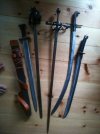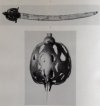- Joined
- Aug 16, 2011
- Messages
- 1,386
Yeah, those guys don't seem to have the most refined technique. I wonder if many of them knew how to properly use a sword but in the heat of the moment they reverted to just swinging wildly.
I'll give that a shot, thanks. I had read about that tree thing before, are these guys really fighting at such close quarters? You'd have to almost be on top of the other guy to hit them with a stroke like that.
Blue-try lockin your wrist at a 45 degree angle to your forearm, instead of 90. The Kalaripayatu (Sp???) guys will stand with one knee up against a tree trunk, and cut right and left w/o hitting the tree.
I do the 45 degree trick with the kilij I made years ago and it will cut a refrigerator box in half if you do it right. Thrusts with that curvature are very elliptical-again much easier to do with wrist locked @45 than 90. Kinda like a looping overhand punch like some of the panantukan long hooks.
I'll give that a shot, thanks. I had read about that tree thing before, are these guys really fighting at such close quarters? You'd have to almost be on top of the other guy to hit them with a stroke like that.


